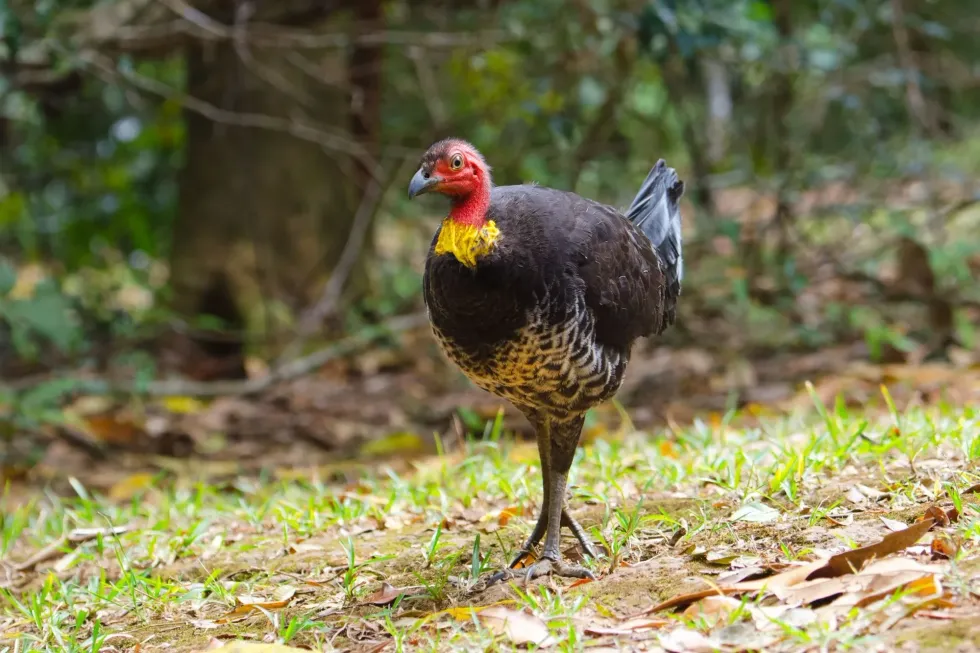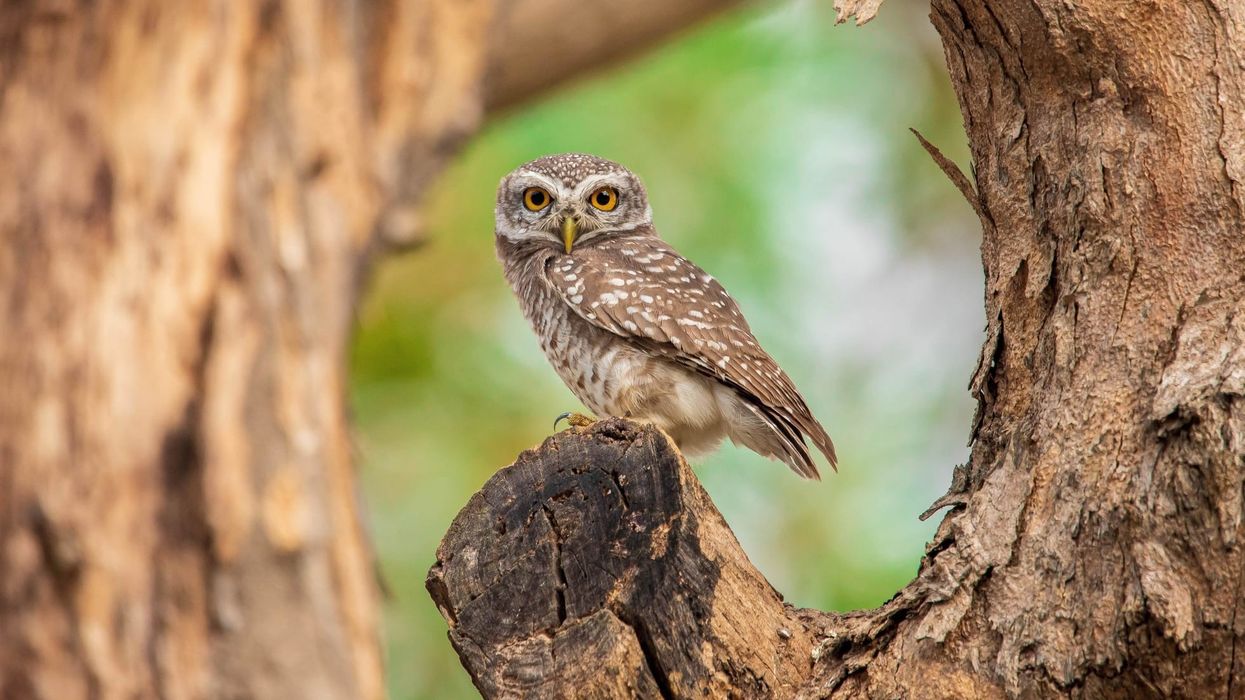The Australian brush turkey (Alectura lathami) is a common, widespread species of mound-building bird found in eastern Australia. The Australian brushturkey has also been introduced to Kangaroo Island in South Australia.
It is the biggest extant member of the Megapodiidae family and one of three species found in Australia. A brightly colored head crowns a black body with neck wattles, which is supported by powerful legs, a flat tail, and broad digging feet.
The Australian brush turkey chick has a significant risk of mortality since they are mostly on their own from birth. The chances of a bird surviving to adulthood are as low as one in 200!
Despite its name and superficial resemblance, the bird is neither related to American turkeys nor to Australian bustards, often known as the bush turkey. The yellow wattle brushturkey, Waigeo brushturkey, and malleefowl are its closest relatives.
If you like this article, check out our leghorn chicken facts and prairie chicken facts here on Kidadl.
Australian Brush-Turkey Interesting Facts
What type of animal is an Australian brush-turkey?
Alectura lathami is a bird belonging to the order Galliformes and of the megapodes family.
What class of animal does an Australian brush-turkey belong to?
These bare red-headed birds belong to the class Aves.
How many Australian brush-turkeys are there in the world?
There are over 100,000 individuals present now. Brushturkeys are quite abundant, although the species was thought to be on the verge of extinction in the 1930s.
Where does an Australian brush-turkey live?
Brushturkeys in Australia are found in highland rainforests and damp woods near coastlines. They can be found further inland in drier scrubland. This bird frequents urban forested areas and has been observed in Brisbane and Sydney, taking over household compost heaps as possible mound sites.
What is an Australian brush-turkey's habitat?
The Australian brushturkey's habitat is moist sclerophyll forests and rainforests, but it may also be found in drier scrubs. The Australian brush turkey is more prevalent at higher altitudes in the northern portion of its range, but some migrate to lowland regions during the winter months.
It is widespread in both highland and lowland areas in the south. Its range stretches over the northern suburbs of Sydney and the Illawarra area in New South Wales to eastern Australia, from the Cape York Peninsula in Queensland.
Who do Australian brush-turkeys live with?
These birds are solitary and timid in nature, although they will spend the night in communal tree roosts. It is common for them to roost in groups and hunt alone most of the time, but they may gather around food together.
How long does an Australian brush-turkey live?
They're known to live at least nine years in the wild. In managed care, they live for a maximum of 10-11 years.
How do they reproduce?
Both sexes show their bright neck wattle and feathers in mating displays. Like other megapodes, they incubate their eggs in huge mounds during the breeding season.
The males typically construct nests (incubation mounds) using enormous mounds of organic materials. Several females lay eggs in a single mound.
The heat emitted by the decaying foliage helps in the incubation of the eggs. The male keeps a steady temperature of 91.4-100.4 F (33-38 C) in the nest by drilling holes in the mound and inserting his bill to check the temperature. Chicks hatch underground.
The average clutch size is 50 eggs in a single mound (laid by several females). Around 15-27 eggs are laid in the breeding season by a single female.
What is their conservation status?
It has never been endangered, but it has grown rare across broad regions due to habitat degradation and predation by cats and foxes. Though it is classified as of Least Concern by the IUCN.
Australian Brush-Turkey Fun Facts
What do Australian brush-turkeys look like?

The Australian brushturkey is distinguished by its mostly black body plumage, bare red head, yellow throat wattle, which is pale blue in northern birds, and laterally flattened tail. The wattle of females and young birds are a pale yellow.
The undersides of the birds are covered with white feathers, and their tails are broad, fan-like, and laterally flattened. Their bill is black with a hook on it.
The male's wattle diminishes and loses part of its brilliant yellow color outside of the breeding season. During breeding, the yellow neck wattle of adult males forms a conspicuous, thick pouch. Its head and neck become dark pink and featherless.
The head and neck are smaller than the body. It has white feathers on its underbelly and yellow on its neck.
How cute are they?
It is distinct from any other Australian bird. Australian brush turkey chicks are tiny, chubby birds with dark brown feathers and flat tails, unlike their parents, so they can be called cute.
How do they communicate?
Australian brush-turkeys are generally silent, but they may exchange faint grunts. The male Australian brush turkey call is three-note and loud booming.
How big is an Australian brush-turkey?
They are 23.6-27.6 in (60-70.1 cm ) in body length. An Australian brush-turkey's wing length is around 11.7-13.1 in (29.7-33.2 cm).
How fast can an Australian brush-turkey fly?
It prefers to walk or run, and it only takes flight to avoid danger or to roost in trees. It almost never flies. Their flight speed is not known.
How much does an Australian brush-turkey weigh?
Males weigh 4.6-6.6 lb (2-3 kg) and females weigh 4-6 lb (1.8-2.7 kg).
What are the male and female names of the species?
Males older than a year are referred to as 'toms' or 'gobblers', while those less than a year are referred to as 'jakes'. Female turkeys over a year old are referred to as 'hens', while birds under a year old are referred to as 'jennies'.
What would you call a baby Australian brush-turkey?
An Australian brush turkey baby is called a chick.
What do they eat?
Their diet includes seeds, fallen fruit, and insects. They search for food by moving leaf litter or cracking logs with their huge feet.
The majority of their food comes from the ground, with birds infrequently seen eating on ripening fruits amid tree branches. Seeds, fruits, berries, grains, sprouts, roots, frogs, snails, silkworms, insects and insect larvae, and carrion are all part of their diet.
Are they dangerous?
They're not dangerous but while raking up the ground in search of food, the brushturkey can cause damage.
They can damage gardens and parks as they dig for leaf litter and break twigs and soil ideal for mound construction in just a few hours.
They show little fear in circumstances where they come into contact with humans, such as picnic spots in national parks, urban areas, and residential gardens, and will often brazenly attempt to take food from tables and raid compost bins.
Brushturkeys in more populated regions are less fearful than birds in national parks.
Would they make a good pet?
They are difficult to pet and they damage gardens in urban areas.
Did you know...
They are sometimes hunted for food, especially by Aboriginal Australians as part of their diet. Their eggs, which weigh on average 6.3 oz (178.6 g), are also occasionally consumed. Only megapodes bury their egg inside huge heaps of leaf litter and incubate their eggs using the heat from decomposing vegetation.
The temperature of the nest has an effect on the sex ratio of brushturkey chicks. Lower nest temperatures produce more male chicks, whereas higher nest temperatures produce more female chicks. Chicks are able to regulate their body temperature after they are 24 hours old.
What is a group of brush turkeys called?
Brushturkeys are social birds with communal nests. A typical group comprises of a dominant male, one or more junior males, and numerous females and is called a 'rafter'.
Are Australian brush-turkeys endangered?
Brushturkey's population is decreasing due to habitat loss. Their preferred area, rainforests, has mostly vanished from many regions in Queensland and is under threat. The bird is locally extinct in several places where it had lived before European settlement in Australia.
While brushturkeys may be found in some urban settings, their nesting success is relatively poor in comparison to their native environment. Brushturkeys residing in cities may not contribute to the species' long-term survival.
Nonhuman predators of birds include cats, foxes, quolls, dingoes, dogs, snakes, and goannas. They are rapidly encroaching into human-inhabited regions. In Queensland, the brushturkey is protected.
Here at Kidadl, we have carefully created lots of interesting family-friendly animal facts for everyone to discover! For more relatable content, check out these Nicobar pigeon facts and great grey owl facts for kids.
You can even occupy yourself at home by coloring in one of our free printable brushturkey coloring pages.
Second image by Jim Bendon.










